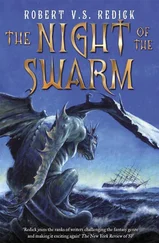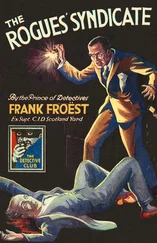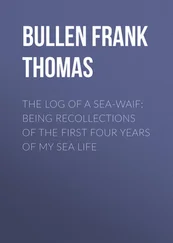'In that case they'd have to be capable of learning,' said Oliviera. 'But how could a single-cell organism learn?'
'Leon and I could try to model a swarm of them electronically. We could give them various characteristics and see how long it takes for them to start acting like a brain.'
'Artificial intelligence?'
'Yes, but with a biological basis.'
'That might be useful. Go ahead,' Li ruled. 'Any other suggestions?'
I'll see if I can find any similar organisms among prehistoric life-forms,' said Rubin.
Li nodded. 'Any news from you. Sam?'
'Not really.' Crowe's voice emerged from a cloud of smoke. 'For the moment we're trying to decipher old Scratch signals while we wait for a reply.'
'Maybe you should have sent the yrr something a bit more challenging than a couple of sums,' said Peak.
The smoke cleared and Crowe's beautiful, time-worn face emerged with a smile. 'Just be patient, Sal.'
WELL DECK
Roscovitz had devoted his life to the US Navy and saw no reason to change. It was his belief that people should do what they did best, and since he'd always liked being under water, he'd embarked on a career in submarines, working his way up to commander.
But he also believed that curiosity was one of the most important characteristics a person could possess. He had plenty of respect for loyalty, commitment and patriotism, but mindless drilling wasn't in his nature. At some stage it had occurred to him that submarine commanders knew nothing about the world in which they lived, so he'd decided to inform himself. Of course, he hadn't become a biologist overnight, but his enquiring mind had come to the attention of the technological division of the navy, which was on the look-out for people who were loyal enough to behave like soldiers but agile enough intellectually to play an executive role in research.
Once the decision had been taken to prepare the Independence for an expedition to the Greenland Sea, Roscovitz had been entrusted with finding her a state-of-the-art dive station. Many people saw her as humanity's last hope, which meant no expense was to be spared. Roscovitz was told to purchase whatever seemed useful, at any price, and to commission anything that didn't already exist – on the proviso that it could be built before they sailed.
No one had seriously expected him to consider using manned submersibles. ROVs were the obvious choice; vehicles like Victor, which had tracked down the Norwegian worms. The AUV was a serious option too: unlike Victor, there was no cable to connect it to the ship and most robots came with high-resolution cameras and either an articulated grasper or precision-operated artificial arms. Given the number of divers who'd been attacked or killed already, no one was keen to put human lives at risk. These days, even paddling was dangerous.
Roscovitz had listened to their objections and told them to forget it. 'Since when have we ever won a war using nothing but machines?' he'd argued. 'Sure, we can fire off smart bombs or send unmanned drones into enemy territory, but no robot can make the kind of decisions a fighter pilot takes. At some point in this mission we're going to have to go down and deal with the problem ourselves.'
They'd asked what he had in mind. ROVs and AUVs, he'd said, plus manned submersibles with weaponry. He'd also requested a dolphin fleet, and discovered, to his satisfaction, that MK6 and MK7 had been assigned to the mission at the request of a scientist. When he'd heard who'd be in charge of the dolphins, he'd been doubly pleased.
Roscovitz hadn't met Jack O'Bannon personally, but the ex-diver was well known in certain navy circles. When he'd resigned he'd refused to have anything to do with the navy. Roscovitz knew perfectly well that O'Bannon didn't have any kind of heart defect so he was surprised to find him back on board.
His superiors had tried to persuade him that there wouldn't be any call for manned submersibles, but Roscovitz wouldn't listen. In the end he got the green light.
Then he'd startled them again.
In all probability, the Department of the Navy had expected him to pack the stern of the enormous helicopter-carrier with the big-name submersibles, like the Russian MIR subs, the Japanese Shinkai and the French Nautile. With good old Alvin, they belonged to the half-dozen or so craft in the world capable of descending to a depth of 3000 metres. But Roscovitz was more interested in innovation. Shinkai could reach 6500 metres, but its ascent and descent relied on flooding and emptying its ballast tanks. The same was true of the MIR submersibles and Nautile.
But Roscovitz wasn't envisaging a conventional deep-sea expedition: it was war against an unknown enemy. Relying on regular submersibles would be like using hot-air balloons to fight a battle in the air. Most submersibles were too cumbersome for his purposes. He wanted deep-sea jets. Fighter planes.
It didn't take long to find a company that seemed to be working more along his lines. Hawkes Ocean Technologies, based in Point Richmond, California, had an excellent reputation, and not just within the industry. Hollywood often relied on its expertise whenever high-tech vessels were required. Graham Hawkes, a renowned engineer and inventor, had founded the firm in the mid-nineties to pursue his dream of flying under water.
Roscovitz had drawn up a wish list and placed it on the table with a large amount of cash. He had one stipulation: the firm would have to undercut every known record for building a submersible.
The cash had sealed the deal.
As the scientists lined up on the jetty at ten thirty, clad from head to toe in thermally insulating neoprene suits Roscovitz was pleased to be able to teach them something for once. The induction for the military and crew had taken place in Norfolk, Virginia. Most of them were navy SEALs, who were so used to the water that they'd practically grown fins. But Roscovitz was determined to ensure that the scientists were capable of deep-sea flying and fighting as well. He knew that things could happen during an expedition that meant civilians had to play a decisive role.
He instructed his chief technician, Kate Ann Browning to lower one of the four submersibles from the rail overhead. Deepflight 1 descended slowly towards them. The underside of the boat resembled a larger-than-life Ferrari without wheels, equipped with four long, thin cylinders. He waited until it was suspended at eye-level, four metres above the deck and directly over the basin. Seen from that angle, it had little in common with a conventional submersible. Flat, wide and almost rectangular in shape, with four thrusters mounted at the rear and two partially transparent body pods sloping up towards the front, the Deepflight looked more like a spaceship. Below the transparent domes, a pair of articulated arms protruded from the bow. Most noticeable of all were the vessel's stubby wings.
'I expect you're thinking it looks like a plane,' said Roscovitz, 'and you'd be right. It is a plane, and it's every bit as manoeuvrable. The wings serve the same purpose as they would on a plane, only they're angled in the opposite direction. The wings of an aeroplane generate lift. The wings on a Deepflight generate a downward force that counteracts the lift. Even the steering system is modelled on aeronautical principles. You don't sink like a stone; you move at an angle of up to sixty degrees, so you can bank elegantly from side to side or shoot up or down.' He made swooshing noises as he demonstrated the movements with the flat of his hand. He pointed to the pods. 'The main difference from an aeroplane is that you don't sit down. You lie prone. That way the height of the vehicle is kept to just one point four metres for a surface area of three by six metres.'
'How deep can it dive?' asked Weaver.
Читать дальше












